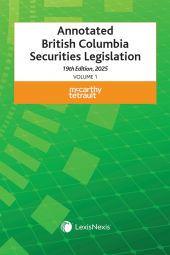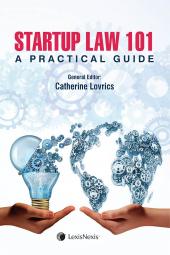Startup Law 101: A Practical Guide
The book offers comprehensive advice on the various legal considerations involved in establishing and running a successful startup company. With contributions from numerous leading practitioners, this book provides helpful guidance on the different stages of starting a business – from its formation and funding, to operationalizing, to building and protecting its IP assets.
One Year Subscription Only Terms
Subscribers receive the product(s) listed on the Order Form and any Updates made available during the annual subscription period. Shipping and handling fees are not included in the annual price.
Subscribers are advised of the number of Updates that were made to the particular publication the prior year. The number of Updates may vary due to developments in the law and other publishing issues, but subscribers may use this as a rough estimate of future shipments. Subscribers may call Customer Support at 800-833-9844 for additional information.
Subscribers may cancel this subscription by: calling Customer Support at 800-833-9844; emailing customer.support@lexisnexis.com; or returning the invoice marked 'CANCEL'.
If subscribers cancel within 30 days after the product is ordered or received and return the product at their expense, then they will receive a full credit of the price for the annual subscription.
If subscribers cancel between 31 and 60 days after the invoice date and return the product at their expense, then they will receive a 5/6th credit of the price for the annual subscription. No credit will be given for cancellations more than 60 days after the invoice date. To receive any credit, subscriber must return all product(s) shipped during the year at their expense within the applicable cancellation period listed above.
Product description
"Startup Law 101 is a manual that offers a wealth of useful information to startup company founders and operators, and those who may advise them...the book will assist lawyers who encounter clients engaged in startup ventures to spot issues for their own handling or for potential referral."
Reviewed by Kim Nayyer, Associate Univeristy Librarian, Law
University of Victoria
See Review in 2019 Canadian Law Library Review 44:1 (page 21)
Startup Law 101: A Practical Guide offers comprehensive advice on the various legal considerations involved in establishing and running a successful startup company. With contributions from numerous leading practitioners, this book provides helpful guidance on the different stages of starting a business – from its formation and funding, to operationalizing, to building and protecting its IP assets.
Valuable insight
Organized into three sections, Startup Law 101: A Practical Guide includes useful information that will help entrepreneurs and their legal advisors set up, run and grow a business.
Part 1 sets out the options for forming and funding a business, and explains:
- the various business structures and the tax implications of each
- how and where to incorporate a business, including tips on organizing the business post-incorporation
- how to finance a business through debt or equity, including the differences between them and the issues associated with raising capital through equity
- shareholder agreements, outlining various types and common provisions
- alternative forms of financing, including crowd-funding and sweat equity agreements
- common funding structures, including lists of different sources of funding available in Canada
Part 2 explains the legal aspects of business operations, including:
- key considerations for hiring staff, such as classifying workers as independent contractors or employees, employment standards and statutory entitlements, contractual and human rights issues, and workplace policies and procedures
- consulting agreements, with details of different agreement types and possible provisions to include, with examples of each
- the legal and regulatory regime for advertising as well as comparative advertising, online behavioural advertising and other forms of advertising
- defamation – what it is, defences to it and how it applies on the Internet
- privacy, including guidance to comply with the applicable regulatory framework
- Terms of Use, when they should be used, potential limitations and draft clauses
Part 3 offers insight into building a business' intangible assets, including:
- an overview of IP rights, a chart outlining basic facts about those rights in Canada and the U.S., and an IP cheat sheet
- an overview of trademarks – important branding considerations, including how to select a trademark and determine if it's available, as well as protecting and enforcing a trademark
- an introduction to copyright - what it is, what it protects, the rights it confers, how it is enforced, moral rights, remedies for infringement and clearance of third-party copyright
- an explanation of design protection, including what can be protected, how design interfaces with other forms of IP, novelty and originality requirements, the registration process, securing protection in other countries, ownership and infringement
- an overview of trade secrets and associated considerations
- an introduction to patents, the patent process and regulatory issues
- a chapter dedicated to IP protection for engineering and technology startups
- specialized content related to biotechnology patents
- a step-by-step breakdown of IP due diligence, with a view to be positioned for an "exit"
Special features
The precedents, lists and charts included in Startup Law 101: A Practical Guide are invaluable and set this resource apart. They include:
- a list of different funding sources available in Canada, organized by funding source
- a chart explaining the advantages of classifying an individual as an employee or a contractor
- a chart summarizing the applicable statutory entitlements in each province (i.e., minimum wage, vacation time, vacation pay, overtime, etc.)
- an employment agreement template for Ontario employers
- an independent contractor agreement template
- a respectful workplace policy template
- sample consulting agreement clauses
- sample terms of use clauses
- top 10 list of considerations when drafting terms of use provisions
- a chart outlining the basic facts about IP rights
- trademark dos and don'ts
- an industrial design checklist to assist with identifying industrial designs, determining ownership and the registration process
- a trade secret checklist
- buyer and seller due diligence checklists
Who should buy this book?
Startup Law 101: A Practical Guide is particularly useful for anyone who is involved with a startup company –as a business owner or an advisor:
- General practitioners advising startups in early days
- Corporate/commercial lawyers advising clients about starting a company
- Intellectual Property lawyers with clients establishing a startup and needing advice on protecting their intellectual property
- In-house counsel working at a startup
- Entrepreneurs seeking to understand the legal considerations involved in creating and running a startup, particularly if they don't have counsel or a legal background
- Students in graduate, law or business school, including combined MBA programs, enrolled in entrepreneurship, private equity or venture capital courses
Table of contents
Chapter 1: Organizing Your Business: Tax and Other Implications of Different Business Vehicles (by Luigi Valente, formerly Wildeboer Dellelce LLP, and Amir Torabi, Wildeboer Dellelce LLP)
Related products
-
New!Preorder
 Canada Business Corporations Act & Commentary, 2024/2025 EditionNew!Release date: July 31, 2024$45.00
Canada Business Corporations Act & Commentary, 2024/2025 EditionNew!Release date: July 31, 2024$45.00 -
New!Preorder
 Annotated British Columbia Securities Legislation, 19th Edition, 2025 (2 Volumes)New!Release date: July 31, 2024$225.00
Annotated British Columbia Securities Legislation, 19th Edition, 2025 (2 Volumes)New!Release date: July 31, 2024$225.00 -
New!Preorder
 Ontario Business Corporations Act & Commentary, 2024/2025 EditionNew!Release date: July 31, 2024$45.00
Ontario Business Corporations Act & Commentary, 2024/2025 EditionNew!Release date: July 31, 2024$45.00
 Lexis Nexis
Lexis Nexis 
